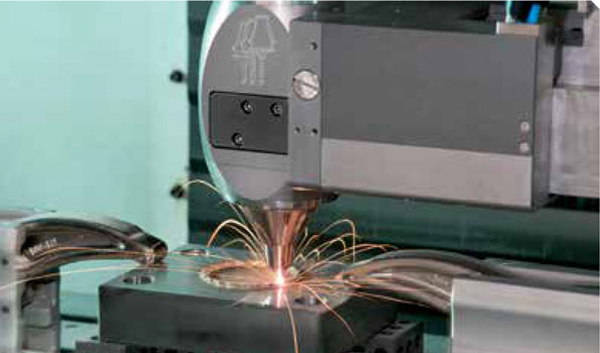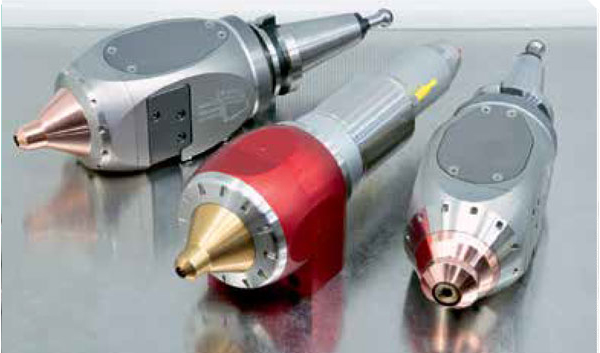Ensuring Maximum Productivity

A CNC-based hybrid tool solution, the Ambit multi-task system, from Hybrid Manufacturing Technologies, can be integrated into almost any CNC metalworking machine. With an upgrade to Beckhoff’s PC-based control platform with EtherCAT as the fast fieldbus system, the Ambit solution enables the alternate use of metal removal and metal deposition heads in the tool spindle, and ensures optimized machine communication.
The hybrid tool solution from Hybrid Manufacturing Technologies combines conventional CNC technology and additive production processes with the ability to provide both machining and metal deposition tools on the same spindle. The tool change is performed automatically. Machine tool manufacturers who opt for the Ambit hybrid solution can expand the possibilities of their standard CNC machine by integrating additive manufacturing without additional and tedious re-clamping operations and programming steps. The post-treatment of components, such as polishing, milling and surface sandblasting, can also be done with the same machine equipment – so that transfer to another production cell for finishing is not required. The use of different material compositions for the same product is also possible, and inspection during production guarantees quality grades that cannot otherwise be achieved or determined.

The hybrid system is controlled via a Beckhoff CP2218 multi-touch Panel PC.
Fully-automatic tool change for CNC machining and 3D printing
“The Ambit hybrid kit was developed to offer compatibility with most CNC machine configurations and robot platforms,” explains Dr Jason Jones, Managing Director and Founder, Hybrid Manufacturing Technologies. “Equipping an existing multi-axis CNC machine with automatically exchangeable deposition heads makes 3D printing in metal possible without having to purchase a separate machine. This not only reduces costs, but also enables extensive options in the operation of CNC machines.”
The hybrid system supports a wide range of processing heads with different geometries, laser profiles, powder supply configurations and unfocused beams in order to enable a variety of processing steps. These include 3D metal application, welding, marking, chipping, drilling, pre-heating, annealing/relief, surface re-melting and cleaning, and much more. The standard equipment can accommodate up to 15 processing heads. However, an unlimited number of heads can be added, depending on the space in the tool changer and the control system performance.
Beckhoff control technology selected as the new standard
The Ambit control platform consists of a CP2218 Panel PC with 18.5-inch multi-touch display that runs TwinCAT 3 automation software, as well as an EK1100 EtherCAT Coupler with in-line connected EtherCAT I/O Terminals. “Hybrid Manufacturing Tech-nologies was particularly impressed by the HMI solution from Beckhoff and the possibility to use EtherCAT technology in the processing head,” stresses Dr Jones.
Peter Coates, Co-founder, Hybrid Manufacturing Tech-nologies, adds: “We can supply our customers with processing heads tailored precisely to unique application requirements that are usable on just about any machine tool. The use of EtherCAT as the communication system makes connection to other production cells simple. TwinCAT 3 also simplifies the connection to other company systems, even extending into the integration of customer-owned Ethernet-based control and ERP solutions. In the future, we will continue using Beckhoff control technology as the standard in the advanced hybrid solutions we supply to the global market.”

The hybrid tool solution developed by Hybrid Manufacturing Technologies facilitates the alternate use of chipping and metal application heads in the tool spindle.

The hybrid system supports a wide range of processing heads with different geometries, laser profiles, powder supply configurations and unfocused beams.
Efficient engineering with TwinCAT 3
“It was a significant upgrade from our previous solution, and after a minimum amount of training, we were able to integrate all our engineering processes into TwinCAT 3. The advantage of programming with structured text is that we do not have to change the platform; instead, we can simply add new PLC code. This means that all controllers run programs made with the same code, which is incredibly helpful,” comments Coates on the transition to the PC-based control solution.




 Facebook
Facebook.png) Twitter
Twitter Linkedin
Linkedin Subscribe
Subscribe